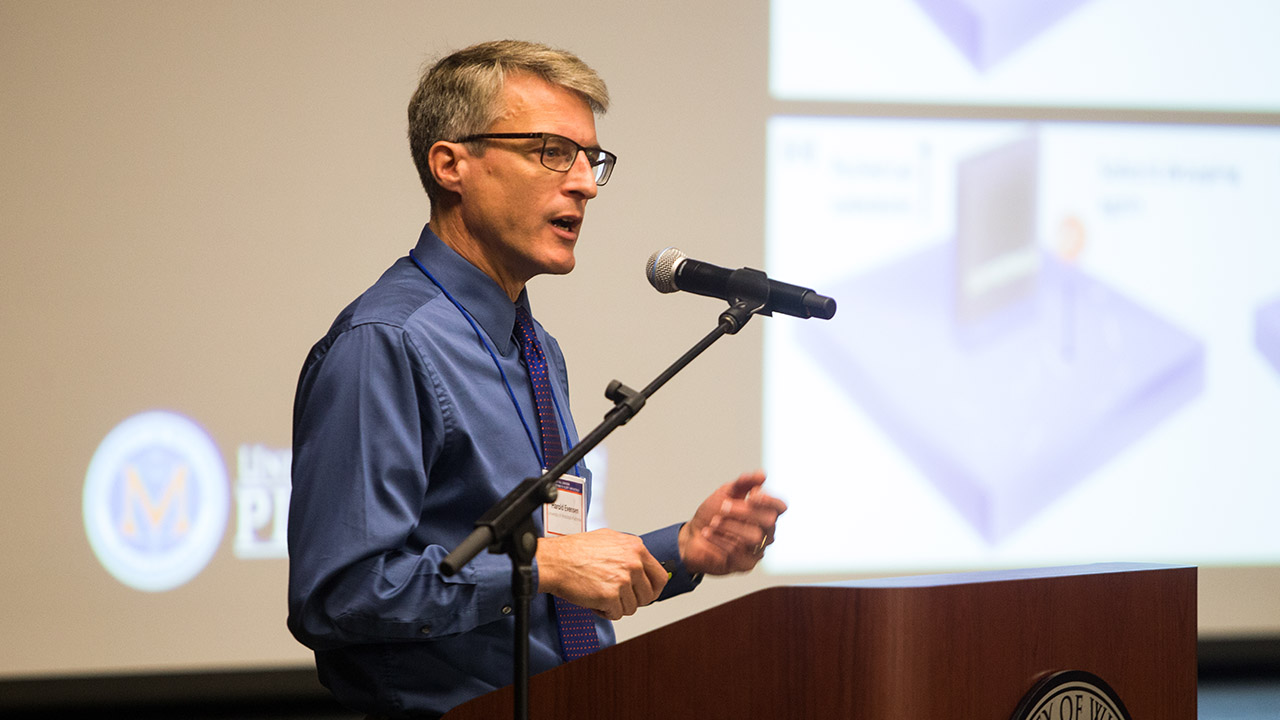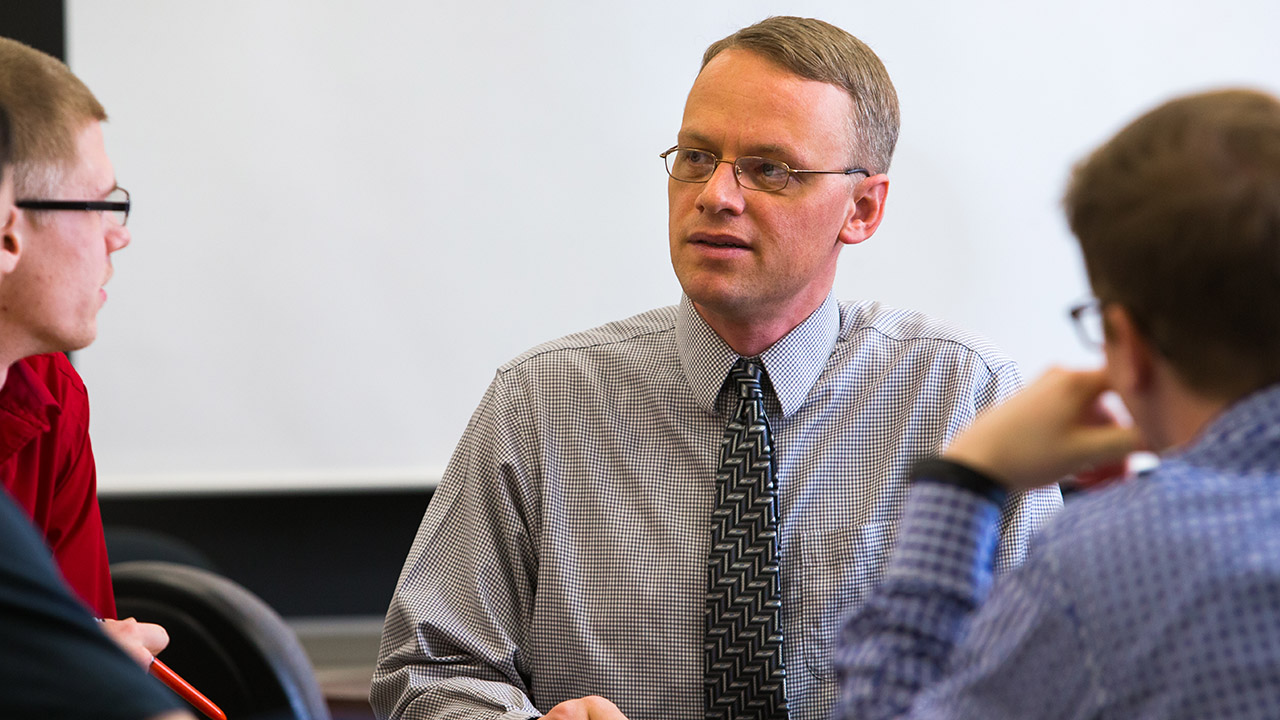

WiSys, the technology transfer arm of the 11 UW System regional comprehensive campuses, was recently awarded U.S. patents for inventions disclosed by two College of Engineering, Mathematics and Science faculty at UW-Platteville. Dr. Hal Evensen, professor of engineering physics and co-inventor Charles Nelson, a 2018 UW-Platteville electrical engineering graduate, created the “Planar Field Emission Transistor.” Dr. Thomas Zolper, associate professor of mechanical engineering, and his team, which included alumnus Corey Flores, a 2016 mechanical engineering graduate, invented the “Variable Volume Flow Injection Nozzle.”
“Our faculty play an integral role in our personal, hands-on, 'discover by doing' approach to education. It’s exciting to see patents as outcomes of faculty and students working together. This is true innovation in action,” said Dr. Molly Gribb, dean of the College of Engineering, Mathematics and Science.
This is the first patent Evensen has received for his research done at UW-Platteville and his first patent he has earned with a student. “It’s extra special,” he said. “Charles and I came up with the idea about five years ago. It’s a nice recognition. Where it goes as far as inventions remains to be seen.”
“It’s validation for a lot of hard work and calculations. They were challenging projects,” said Zolper. “These patent applications were submitted about five years ago.”
Zolper was approached by the U.S. Geological Survey about a project to help stop the spread of invasive carps and zebra mussels throughout the United States. Zolper and Flores collaborated with USGS Biologist James Luoma, out of the USGS Upper Midwest Environmental Sciences Center in La Crosse, Wisconsin, to develop a molluscicide application system.
“The variable volume flow rate injection nozzle releases a paper-thin layer of zebra mussel pesticide that falls straight down to the bottom of the pond,” said Zolper. “We had to design equipment that would allow a boat go slowly in one direction and while a layer of zebra mussel pesticide was injected in the opposite direction at the same speed. With the combined velocity of zero, it falls to the bottom of the pond like a sheet of paper.”
Zebra mussels have invaded different waterways in Wisconsin and Minnesota, including the Great Lakes. According to Zolper, the species entered the lakes from large shipping vessels traveling from the Baltic Sea.
“They out compete native species and they adhere to a lot of solid objects such as docks, boats and even propellors. They even grow on some of our native species like crayfish and clams.” he said. “Many cities draw water from zebra mussel affected waterways. The intake pipes can become blocked with zebra mussels which prevents the flow of water. Molluscicides were developed to selectively target zebra mussel and prevent clogging of water pipes. We adapted the principle to treat natural waterways.”
Zolper appreciates the ongoing relationship between the university and USGS. He is currently working with research biologists on other projects including the use of carbon dioxide to prevent migration of invasive fish.
WiSys has assisted both Zolper and Evensen throughout each of their patent processes and are currently seeking industry partners for commercialization. Evensen first contacted WiSys in 2016 after Nelson approached him with the idea of shrinking down vacuum tubes to the nano scale. Vacuum tubes are transistors that control the flows of electric current. According to Evensen, the advantage of vacuum tube technology is it deals with high power and high frequency needs.
“We realized if we shrink that down to the nano scale, we can have the electrodes close enough that they are closer than the typical space between the air molecules,” Evensen said. “The whole point is the electron comes off and doesn’t hit an air molecule. If they are so close it’s like a vacuum. Now you have a vacuum tube without having to create a vacuum; technologically that’s a big deal.”
Evensen explained the other piece of the discovery is similar to a lightning rod effect.
“We are working with carbon nanotubes, which are roughly a nanometer in diameter. There are not many things sharper than that, so now you can emit electrons with a small applied voltage,” he said. “What that does in the big picture, is low voltages mean less energy, which is less heat. What it also means is that when electrons come off they are also at low energy, so even on the off chance they hit an air molecule nothing is going to happen. It combines the close spacing to achieve a vacuum and then the sharp carbon nanotube which allows the electron to come out at low voltage.”
Currently, Evensen and his undergraduate researchers are building upon the patented idea. “We are changing the details of the fabrication. The patent is for a planar geometry. Now we are looking at a different one,” he said. “If this new geometry we are working on looks like it’s going to pan out, then I think we will try to add on to the current patent.”
When Evensen reflects on the moment when Nelson first approached him with this idea, he recalls the both of them in his office brainstorming on a scrap piece of paper.
“If a student has an idea that they are excited about, I want them to chase it down. An excited and engaged student is the best thing,” said Evensen. “To me the biggest win is that it’s on Charles’s resume. The win was the recognition of the student.”
Through WiSys, both inventions are available for licensing. Interested parties can send inquiries to WiSys at licensing@wisys.org for more information.
WiSys is a non-profit supporting organization of the UW System, serving as the dedicated technology transfer office for the system’s 11 regional comprehensive universities, including UW-Platteville. These universities, as a group, were recently ranked second in national innovation impact productivity rankings among smaller research institutions by the George W. Bush Institute. WiSys’ goal is to help the great ideas – born on these UW System campuses – reach the wider world. To learn more visit, www.wisys.org.